- HOME
- SHOP
-
TECHNOLOGY
-
NEWS
-
HELP
- RX INSURANCE
August 03, 2018
As many as 67% of people experience shoulder discomfort at some point over the course of their lives. Shoulder pain often originates from shoulder injuries. Sometimes it can be simply caused by chronic use from strenuous activities like sports. Those who are active, from sports, or even just active chores around the house, often make excessive, repetitive and, sometime, overhead motions that place a lot of stress and pressure on the shoulder, including the surrounding muscles and soft tissues.
Individuals know they have some kind of shoulder pain once they start feeling stiffness, soreness or tenderness within their shoulder. Mobility of the shoulder can become impaired. Some lose strength in the joint, making it difficult for them to complete normal activities as simple as lifting or move around their arm.
It’s important to take action in your daily life to relieve pain and protect yourself from future damage. Stability in the shoulder builds a strong base to solidify shoulder movement and protect against unneeded stress.
What You Can Do
Here are some simple exercises that can be done at home to improve your shoulder stability and overall posture. The best thing about it, they only take a few minutes and can be done without weights. If you have rotator cuff injuries, a shoulder impingement, frozen shoulder, or simply need to strengthen your back, these exercises are for you.
There are two ways to tackle each exercise:
1) Do 3 sets of 10 reps rule.
2) Repeat until until you lose proper form.
Who It’s For: For those with rotator cuff injury or a shoulder that feels “frozen,” particularly with forward motions, in need of strengthening
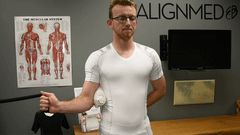 How to Do It: Put a spacer, such as a rolled hand towel between your ribs and your elbow. Once the spacer is firmly in place, simply move your arm towards your body keeping that spacer in place. Move in a counterclockwise motion with your thumb pointed up towards the ceiling. When moving the arm, do not move your shoulder. For extra cueing, try in front of a mirror and use your opposite hand, touch your shoulder to keep it from moving.
How to Do It: Put a spacer, such as a rolled hand towel between your ribs and your elbow. Once the spacer is firmly in place, simply move your arm towards your body keeping that spacer in place. Move in a counterclockwise motion with your thumb pointed up towards the ceiling. When moving the arm, do not move your shoulder. For extra cueing, try in front of a mirror and use your opposite hand, touch your shoulder to keep it from moving.
The Benefit: Improve confidence in forward facing exercise and use, along with better feel and range of motion
Who It’s For: Those who have a “slouching” posture, a bread-and-butter exercise addressing most rotator cuff issues
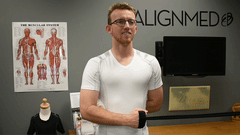 How to Do It: Put a spacer, such as a rolled hand towel between your ribs and your elbow. Once the spacer is firmly in place, simply move your arm away from your body keeping the spacer in place. Move in a clockwise motion with your thumb pointed up towards the ceiling. During this motion, do not move your shoulder.
How to Do It: Put a spacer, such as a rolled hand towel between your ribs and your elbow. Once the spacer is firmly in place, simply move your arm away from your body keeping the spacer in place. Move in a clockwise motion with your thumb pointed up towards the ceiling. During this motion, do not move your shoulder.
The Benefit: This exercise is effective and beneficial to safely increase range of motion and strengthen the rotator cuff.
Who It’s For: For those experiencing a dull aching pain in the shoulder area, especially when doing a lot of overhead motions.
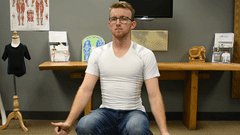 How to Do It: Engage the back by pinching your shoulder blades together. Then with your hands starting from your hips, move your arms toward the sky ending in a T shape. The motion will mimic having wings.
How to Do It: Engage the back by pinching your shoulder blades together. Then with your hands starting from your hips, move your arms toward the sky ending in a T shape. The motion will mimic having wings.
The Benefit: The exercise is beneficial to strengthen the back, improving range of motion and strength.
Who It’s For: If you have tight, limited range of motion, this simple strength exercise opens the back and shoulders at the same time.
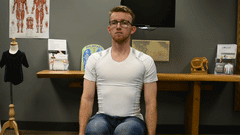 How to Do It: Chest up. With your hands together and thumbs pointed up, move your arms towards the sky ending your hands as high as possible while keeping your shoulder blades together.
How to Do It: Chest up. With your hands together and thumbs pointed up, move your arms towards the sky ending your hands as high as possible while keeping your shoulder blades together.
The Benefit: This exercise is beneficial for enhancing shoulder stability, enabling your body to build a strong base for shoulder movement.
Who It’s For: Feeling weak? This team favorite exercise is great for general strengthening of the shoulder joint area, including general posture realignment.
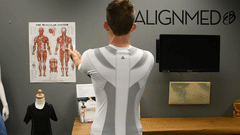 How to Do It: Chest up. Start with your pinkys touching and your thumbs pointing outward. Try to keep the shoulder blades pinched together the entire time. Separate your hands as far as possible and keeping your elbows locked in. Try not to hike up those shoulders! That is a no no for this exercise.
How to Do It: Chest up. Start with your pinkys touching and your thumbs pointing outward. Try to keep the shoulder blades pinched together the entire time. Separate your hands as far as possible and keeping your elbows locked in. Try not to hike up those shoulders! That is a no no for this exercise.
The Benefit: This exercise increases range of motion, strengthens the rotator cuff, ultimately building a strong foundation around the joint for optimal stability during movements.
Who It’s For: For shoulders that feel loose, in need of confidence, or to build as stronger base for support.
 How to Do It: Palms against the wall as if a regular pushup. Lock your elbows. Squeeze your shoulder blades together. Then push up.
How to Do It: Palms against the wall as if a regular pushup. Lock your elbows. Squeeze your shoulder blades together. Then push up.
The Benefit: Relieve pressure on the rotator cuff to prevent potential stress and chronic wear and tear; this promotes increased stability.
Who It’s For: For those with limited range of motion in your back or general rotation of the shoulder.
How to Do It: Have entire back flat against the wall. Elbows against the wall as well as the back of your hand against the wall. In that position move your arms up as high as possible without breaking that position and then move your arms as low as possible with your arms in that same position.
The Benefit: This exercise will increase range of motion in your arms and shoulders while strengthening your rotator cuff as well as other posterior muscle groups in your back.
Free online ACE practice test for 2024 candidates
If you are you a fitness enthusiast looking to enhance your knowledge and skills, consider preparing for the ACE (American Council on Exercise) certification with a free online ACE practice test for 2024 candidates. This test is designed to help you assess your readiness and understanding of essential fitness concepts.
Stabilization Support
Want to reinforce the benefits of these exercises all the time? Take all these routines to the next level with something your body can use all the time…without having to change anything you consciously do. Stabilizing the shoulder is the most consistent way to protect the joint from injury and optimize strength and performance. Positioning in proper alignment allows your body sensors to get the muscle “biofeedback” it needs to operate the joint in optimal fashion.
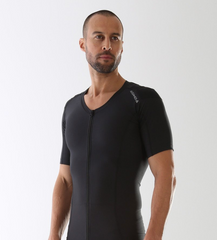 The Alignmed Posture Shirt is designed to provide the body natural biofeedback to set posture, and shoulder position properly. Neuroband technology activates the proper muscle groups, and without the brain even having to think about it, the body learns how to use correct shoulder position, reversing forward shoulder, and other bad habits, all on its own.
The Alignmed Posture Shirt is designed to provide the body natural biofeedback to set posture, and shoulder position properly. Neuroband technology activates the proper muscle groups, and without the brain even having to think about it, the body learns how to use correct shoulder position, reversing forward shoulder, and other bad habits, all on its own.
Learn more about how the AlignMed Posture Shirt can help stabilize your shoulder, and protect against possible pain, injury, stiffness or flexibility limitations.
December 27, 2023
April 17, 2020
September 10, 2018
Products
More Info
SATISFACTION GUARANTEED
FDA REGISTERED
© 2026 Alignmed. All rights reserved. | 1-866-987-5433 | customercare@alignmed.com
